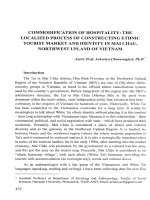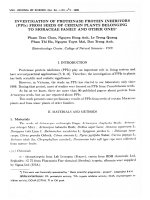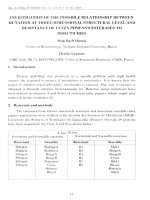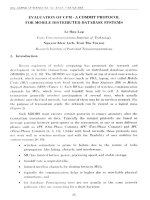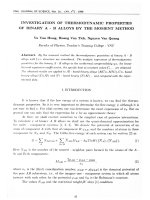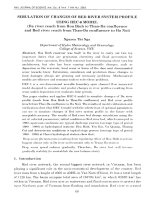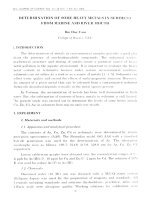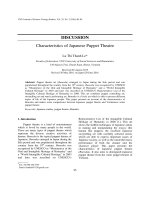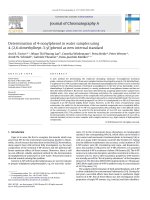DSpace at VNU: Fabrication of PDMS-Based Microfluidic Devices: Application for Synthesis of Magnetic Nanoparticles
Bạn đang xem bản rút gọn của tài liệu. Xem và tải ngay bản đầy đủ của tài liệu tại đây (1.11 MB, 6 trang )
Journal of ELECTRONIC MATERIALS
DOI: 10.1007/s11664-016-4424-6
Ó 2016 The Minerals, Metals & Materials Society
Fabrication of PDMS-Based Microfluidic Devices: Application
for Synthesis of Magnetic Nanoparticles
VU THI THU,1,7 AN NGOC MAI,1 LE THE TAM,2 HOANG VAN TRUNG,3
PHUNG THI THU,3 BUI QUANG TIEN,4 NGUYEN TRAN THUAT,5
and TRAN DAI LAM4,6,8,9
1.—University of Science and Technology of Hanoi, 18 Hoang Quoc Viet, Cau Giay, Hanoi,
Vietnam. 2.—Vinh University, 182 Le Duan, Vinh, Nghe An, Vietnam. 3.—Institute of Materials
Science, Vietnam Academy of Science and Technology, 18 Hoang Quoc Viet, Cau Giay, Hanoi,
Vietnam. 4.—Graduate University of Science and Technology, Vietnam Academy of Science and
Technology, 18 Hoang Quoc Viet, Cau Giay, Hanoi, Vietnam. 5.—Hanoi University of Science, 334
Nguyen Trai, Thanh Xuan, Hanoi, Vietnam. 6.—Duy Tan University, 182 Nguyen Van Linh,
Da Nang, Vietnam. 7.—e-mail: 8.—e-mail:
9.—e-mail:
In this work, we have developed a convenient approach to synthesize magnetic
nanoparticles with relatively high magnetization and controllable sizes. This
was realized by combining the traditional co-precipitation method and
microfluidic techniques inside microfluidic devices. The device was first designed, and then fabricated using simplified soft-lithography techniques. The
device was utilized to synthesize magnetite nanoparticles. The synthesized
nanomaterials were thoroughly characterized using field emission scanning
electron microscopy and a vibrating sample magnetometer. The results
demonstrated that the as-prepared device can be utilized as a simple and
effective tool to synthesize magnetic nanoparticles with the sizes less than
10 nm and magnetization more than 50 emu/g. The development of these
devices opens new strategies to synthesize nanomaterials with more precise
dimensions at narrow size-distribution and with controllable behaviors.
Key words: Microfluidic, microreactor, magnetic nanoparticles,
co-precipitation
INTRODUCTION
Magnetic nanoparticles have become increasingly
attractive in the past few decades due to their
promising potential in biomedical imaging,1 drug
delivery,2 tumor hyperthermia,3 biosensing,4 and
tissue engineering.5 For a given application, it is
critical to control the size, magnetization, as well as
the surface coating of magnetic particles in order to
determine their effectiveness. Indeed, these key
parameters of magnetic platforms can be tuned
through appropriate synthetic procedures.1 Several
synthesis methods for magnetic nanoparticles have
been reported in the literature, mainly including
thermal
decomposition,9–11
co-precipitation,6–8
(Received December 17, 2015; accepted February 20, 2016)
microwave assistance,12 sono assistance,13 and laser
ablation.14 Among these methods, the co-precipitation approach to date represents the best compromise with a wide range of advantages such as the
use of cheap chemicals, mild and water-based
reaction mediums, and easy surface functionalization.1 High-energy approaches offer better control in
size of magnetic particles.9–14 Despite their considerable advantages, these traditional methods pose
challenges to highly precise control in size and
properties of magnetic particles. Thus, the development of a new strategy for synthesis of magnetite
particles is still highly desirable for newly emerging
biomedical applications.
In recent years, microfluidic systems have
emerged as an attractive technology for nanoparticles synthesis.15 These systems enable the automation and high-precision control of reaction
V.T. Thu, Mai, Le The Tam, Van Trung, P.T. Thu, Tien, Thuat, and Lam
conditions; therefore, tuey provide higher levels of
control of particle size and their properties. Another
important feature of microfluidic technology lies in
the high reproducibility due to the limitations of
manual handling. Very importantly, synthetic procedure can be scaled up by integrating a number of
similar microsystems in parallel, thereby increasing
the yield of the desired product. In the last decade,
the use of the microfluidic approach for nanoparticle
synthesis extended to a variety of materials of any
nature including semiconductor,16 metals,17 polymers,18 and metal–organic frameworks (MOFs).19
Only a few works reported the use of microfluidic
systems to synthesize magnetite particles.20,21 The
development of complete device for synthesizing
high-quality materials has attracted much attention
these days.
The main purpose of our present work is to
demonstrate a simple and convenient approach for
synthesis of nanometer-sized magnetite particles in a
continuous process. The use of simplified microfabrication techniques enables low-cost manufacturing
procedures of devices. The spatial confinement and
automated manipulation of liquid flow in microfluidic
devices will probably enable high-precision control in
size and properties of the materials. The product
properties were assessed through morphology and
magnetization, measured using field emission scanning electron microscopy (FESEM) and a vibrating
sample magnetometer (VSM), respectively. The very
first results gained here will be of value in development of continuous large-scale manufacture of nanomaterials in the near future.
EXPERIMENTAL
Materials
Silicon wafers (3 inches in diameter, p-type, h111i)
and SU-8 2050 photoresists were purchased from
MicroChem. Inc., (USA). Poly (dimethylsiloxane)
(PDMS) and curing agent (SYLGARD 184 Silicone
Elastomer) were purchased from Dow Corning Inc.,
(USA). Ferrous chloride (FeCl2) and ferric chloride
(FeCl3) were purchased from Sigma-Aldrich. Sodium
hydroxide and sulfuric acid were purchased from
Sigma-Aldrich. Acetone and isopropanol were purchased from Merck Inc., (Germany).
Apparatus
The photolithography process was performed on a
mask aligner system OAI (OAI, Taiwan). The
activation of PDMS and glass surfaces was conducted on a Pico Diener oxygen plasma oven
(Diener, Germany). A syringe pump (Razel, France)
was used to inject the liquid flows into the device.
Conceptual Design
The configuration of the microfluidic device is
represented in Fig. 1. Basically, the device consists
of a serpentine micromixer, two inlets and one
Fig. 1. Conceptual design of microfluidic device for continuous
synthesis of magnetic nanoparticles. The diameter of inlets and
outlet is 1.6 mm. The height and depth of the serpentine mixer are
15 mm and 50 mm, respectively.
outlet (1.6 mm diameter). The two liquid inlets lead
reagents into a micromixer where the reacting
chemicals can be mixed together. The final product
will be gained at the outlet.
Fabrication of PDMS-Based Microfluidic
Devices
PDMS-based microfluidic devices were fabricated
using a basic process flow in solf-lithography as
described in Fig. 2. A SU-8 photoresist mold was
first created using photolithography, then used to
mold a PDMS pattern, and finally the PDMS fluidic
part was sealed with a glass platform using oxygen
plasma. The detailed process will be described in the
following sections.
Mold Preparation
The photoresist mold was prepared using recommended photolithography program provided by
Microchem. Inc., for a SU-8 2050 photoresist. In
photolithography (from step i to step vi), the geometric patterns from a photo-mask were transferred
on a photoresist film after a short exposure under
UV light. The transparent photomasks with
designed patterns were printed on a local hand-out
printer and then fixed on a glass square fixture
(5 9 5 inches). The exposure time was increased
three times (5 s) to ensure the same luminescence
power was lighted to photoresist film as compared to
a chrome mask. The depth of the fluidic patterns are
determined from the thickness of SU-8 photoresist
film.
PDMS Casting
The PDMS fluidic part was cast from the above
photoresist mold (step vii and step viii). A mixture
containing PDMS base and curing agent (base/
curing agent = 10/1) was poured onto the mold. The
PDMS part was peeled off from the mold after
annealing at 110°C for 1 h.
Bonding
Plasma oxygen bonding technique was used to
stick PDMS fluidic part to a clean glass platform
(step ix). The plasma conditions were 150 W and
90 s. A thermal treatment at 110°C for 1 h was
required to strengthen the adhesion between PDMS
and glass materials.
Fabrication of PDMS-Based Microfluidic Devices: Application for Synthesis
of Magnetic Nanoparticles
Fig. 2. Process flow to fabricate PDMS-based microfluidic device: (i) substrate pretreatment; (ii) deposition of photoresist on silicon substrate;
(iii) pre-baking; (iv) exposure; (v) post-baking; (vi) developing; (vii) modeling; (viii) peeling off; (ix) bonding PDMS fluidic part to glass platform
using oxygen plasma.
Synthesis of Magnetic Nanoparticles
2 M FeCl2 and 1 M FeCl3 solutions were prepared
in HCl 1 M. The mixture of iron (II) and iron (III)
acidic solutions were injected into the device at one
inlet while 5 M NaOH solution was injected into the
device from the other inlet. The molar ratio [Fe2+]/
[Fe3+] was 1/2. The flow rate was set to be 1 ml/h.
The formation of magnetic particles was indicated
by the appearance of a dark precipitate that could
be attracted easily by an external magnet. The final
product was washed several times with deionized
water, then washed with ethanol and finally dried
at 60°C for 2 h.
Fig. 3. An image of a PDMS-based microfluidic device (observed
under the camera of an iPhone 5).
Characterization of Magnetic Nanoparticles
The morphology of the samples was observed by
Ultra high resolution scanning electron microscopy
with a (FESEM) Hitachi-S4800. The saturation
magnetization of the samples at room temperature
was measured under the highest magnetic field of
10 kOe using a vibrating sample magnetometer.
RESULTS AND DISCUSSION
PDMS-Based Microfluidic Device
Figure 3 shows an optical image of a device
observed under the camera of an iPhone 5. It can
be seen that the device was manufactured with
desired structure. The zoomed images of well-
defined patterns of the device were also observed
under an optical microscope (data not shown here).
The depth of the microchannels was assumed to be
the same as that with the SU-8 mold. The stylus
profile (Fig. 4) indicated that the device depth is
around 20 lm and almost the same at different
edges.
It must be emphasized that we used a transparent
photomask instead of a chrome mask. In general,
the PDMS patterns were cast from photoresist
molds, which were prepared by photolithography
using a chrome photomask.22 Herein, the chrome
photomask was replaced with a transparent photomask. That means there is no need to conduct
V.T. Thu, Mai, Le The Tam, Van Trung, P.T. Thu, Tien, Thuat, and Lam
Fig. 4. Geometry of SU-8 mold observed under a stylus profiler.
expensive, time-consuming, and multi-steps procedures to prepare the photomask for the lithography
process in our case. The total time to prepare the
mask was about 1 h. The mask manufacturing cost
was dramatically decreased from 500 USD/100 cm2
for chrome mask down to 0.3 USD/100 cm2 for our
mask. This process can generate well-defined
micropatterns smaller than 20 lm.
The stability of the device was tested with
increasing flow rates. The results demonstrated
strong adhesion of the fluidic part onto our glass
platform and no water leakage was obtained within
the working flow rates ranging from 1 to 10 ml/h.
The treatment of PDMS and glass with oxygen
plasma generated hydrophilic surfaces by introducing silanol groups (-Si-OH) and removing methyl
groups (-CH3).23 This allows a better binding to
silicate glass surfaces and a formation of an irreversible seal to create leak-tight channels.
The mixing performance of the device was tested
with using two color dyes as samples. A complete
mixing of the two injected liquids was visibly
observed. The needed time to mix completely the
two liquids is only within several minutes. The fast
and effective mixing in the micromixer would be
very important to ensure contact between reactants
in a chemical synthesis.
Magnetic Nanoparticles
The co-precipitation of ferrous and ferric ions was
conducted in 20-lm deep devices at a molar ratio of
Ferric/Ferrous = 1/2. The formation of iron oxide
magnetic particles inside microfluidic devices was
indicated by the formation of dark precipitates.
Evidently, this precipitate can be quickly attracted
to the bottom of a baker under an external magnetic
field due to high magnetization of the obtained
products.
Figure 5 represents a FESEM image of magnetic
particles obtained in microfluidic devices. It can be
Fig. 5. The SEM image of the magnetic iron oxides particles prepared in the micro-channel.
seen that the particles were formed in spherical
shape with relatively small diameter (about 10 nm).
It was believed that the use of a microreactor can
produce smaller and more uniform nanoparticles.
One unique feature of microfluidic technology is the
capacity to address reacting chemicals in a laminar
regime flow in which liquid streams run in parallel
paths.24 This is the reason why microfluidic technology enables precise control of the size of nanoparticles. It was reported in the literature that the use
of heating, microwave or sono assistance, and
additives can help to narrow the size distribution
of nanoparticles.12–14 Here, the use of the microfluidic approach allows achieving high-precision control of particle size without using such energy
sources.
Magnetic properties of the synthesized magnetic
particles were characterized using a vibrating sample magnetometer (VSM). Figure 6 shows the roomtemperature magnetization hysteresis loops of magnetite particles. Under a large external field, the
Fabrication of PDMS-Based Microfluidic Devices: Application for Synthesis
of Magnetic Nanoparticles
size, better size distribution, and improved magnetic
behavior were observed. The size of the obtained
particles was about 10 nm and the saturated magnetization was more than 50 emu/g. In our future
work, drop-let based microfluidic devices with
improved configurations will be developed to synthesize nanoparticles with selective sizes. The other
nanomaterials (crystal nanomaterials, metal
nanoparticles, MOFs and so on…) will be the next
objectives.
ACKNOWLEDGEMENTS
Fig. 6. The magnetization curve of the magnetic particles prepared
in the micro-channel at molar ratio Fe3+/Fe2+ = 1/2.
magnetizations of all magnetic domains align with
the field direction and reach their saturation value.
The maximal magnetization was determined (from
the magnetization curve) to be 50 emu/g. However,
it must be noticed that the real value saturation
magnetization must be higher than the practical
value for small magnetic particles (less than 10 nm)
due to particle size effects.25 The exact value of
saturation magnetization should be further determined from the law of approach saturation.25
The relatively high value of magnetization is in
agreement with our previous observations. Nevertheless, the desired saturation magnetization of
magnetic particles for biomedical applications such
as a magnetic resonance image (MRI) and hyperthermia treatment must be more than 70 emu/
g.11,26–28 Thus, the device configuration and experimental conditions need to be improved in our
further works to gain better quality of the
materials.
The batch-preparation of magnetite particles was
also performed at the same conditions at room
temperature. In comparison to the characteristics of
magnetic iron oxide nanoparticles formed in batchsynthesis (data not shown here), the ones formed
inside the micro-channel have a smaller size and
higher magnetization.
CONCLUSION
A simple microfluidic system capable of mixing
and controlling reaction conditions was developed for
synthesis of magnetic nanoparticles. The usual softlithography techniques were simplified to lower the
manufacturing cost of the microfluidic systems and
satisfy low-resource conditions at our laboratory.
Compared with batch-synthesis, the continuous synthesis in microfluidic devices helps to accelerate and
automate the synthesis of iron oxide nanoparticles.
Consequently, magnetite nanoparticles with smaller
This work received financial support from the
Vietnam Academy of Science and Technology (VAST
03.01/15-16) and National Foundation for Science
and Technology Development (NAFOSTED, 104.042014.36). This work was partly funded by University
of Science and Technology of Ha Noi (Nano 1).
REFERENCES
1. T.-H. Shin, Y. Choi, S. Kima, and J. Cheon, Chem. Soc. Rev.
44, 4501 (2015).
2. L.D. Tran, N.M.T. Hoang, T.T. Mai, H.V. Tran, N.T.
Nguyen, T.D. Tran, M.H. Do, Q.T. Nguyen, D.G. Pham,
T.P. Ha, H.V. Le, and P.X. Nguyen, Colloid. Surf. A 371,
104 (2010).
3. A.E. Deatsch and B.A. Evans, J. Magn. Magn. Mater. 354,
163 (2014).
4. N.N. Thinh, P.T.B. Hanh, T.V. Hoang, V.D. Hoang,
L.H. Dang, N.V. Khoi, and T.D. Lam, Mater. Sci. Eng. C 33,
1214 (2013).
5. S. Gil and J.F. Mano, Biomater. Sci. 2, 812 (2014).
6. M.C. Mascolo, Y. Pei, and A. Terry, Materials 6, 5549
(2013).
7. J.S. Basuki, A. Jacquemin, L. Esser, Y. Li, C. Boyer, and
T.P. Davis, Polym. Chem. 5, 2611 (2014).
8. S. Wu, A. Sun, F. Zhai, J. Wang, W. Xu, Q. Zhang, and
A.A. Volinsky, Mater. Lett. 65, 1882 (2011).
9. S. Sun and H. Zeng, J. Am. Chem. Soc. 124, 8204 (2002).
10. K. Woo, J. Hong, S. Choi, H.-W. Lee, J.-P. Ahn, C.S. Kim,
and S.W. Lee, Chem. Mater. 16, 2814 (2004).
11. M.G.- Weimuller, M. Zeisberger, and K.M. Krishnan,
J. Magn. Magn. Mater. 321, 1947 (2009).
12. W.-W. Wang, Y.-J. Zhu, and M.-L. Ruan, J. Nanopart. Res.
9, 419 (2007).
13. N. Wang, L. Zhu, D. Wang, M. Wang, Z. Lin, and H. Tang,
Ultrason. Sonochem. 17, 526 (2010).
14. J. Zhang, M. Post, T. Veres, Z.J. Jakubek, J. Guan,
D. Wang, F. Normandin, Y. Deslandes, and B. Simard,
J. Phys. Chem. B 110, 7122 (2006).
15. S. Marre and K.F. Jensen, Chem. Soc. Rev. 39, 1183 (2010).
16. E.M. Chan, A.P. Alivisatos, and R.A. Mathies, J. Am.
Chem. Soc. 127, 13854 (2005).
17. V.S. Cabeza, S. Kuhn, A.A. Kulkarni, and K.F. Jensen,
Langmuir 28, 7007 (2012).
18. J. Puigmartı´-Luis, M. Rubio-Martı´nez, U. Hartfelder,
I. Imaz, D. Maspoch, and P.S. Dittrich, J. Am. Chem. Soc.
133, 4216 (2011).
19. M. Faustini, J. Kim, G.-Y. Jeong, J.Y. Kim, H.R. Moon,
W.-S. Ahn, and D.-P. Kim, J. Am. Chem. Soc. 135, 14619
(2013).
20. L. Frenz, A.E. Harrak, M. Pauly, S. Begin-Colin, A.D.
Griffiths, and J.-C. Baret, Int. Ed. Angew. Chem. 47, 6817
(2008).
21. W.B. Lee, C.H. Weng, F.Y. Cheng, C.S. Yeh, H.Y. Lei, and
G.B. Lee, Biomed. Microdevices 11, 161 (2009).
22. D. Qin, Y. Xia, and G.M. Whitesides, Nat. Protoc. 5, 491
(2010).
23. J. Zhou, A.V. Ellis, and N.H. Voelcker, Electrophoresis 31,
2 (2010).
V.T. Thu, Mai, Le The Tam, Van Trung, P.T. Thu, Tien, Thuat, and Lam
24. G.M. Whitesides, Nature 442, 368 (2006).
25. L.L. Balcells, J. Fontcuberta, B. Martinez, and X. Obradors,
Cond. Matt. 10, 1883 (1998).
26. B. Mehdaoui, A. Meffre, J. Carrey, S. Lachaize, L.-M.
Lacroix, M. Gougeon, B. Chaudret, and M. Respaud, Adv.
Func. Mater. 21, 4573 (2011).
27. T.T. Luong, T.P. Ha, L.D. Tran, M.H. Do, T.T. Mai, N.H.
Pham, H.B.T. Phan, G.H.T. Pham, N.M.T. Hoang, Q.T.
Nguyen, and P.X. Nguyen, Colloid. Surf. A 384, 23 (2011).
28. T.K.O. Vuong, D.L. Tran, T.L. Le, D.V. Pham, H.N. Pham,
T.H.L. Ngo, H.M. Do, and X.P. Nguyen, Mater. Chem.
Phys. 163, 1 (2015).

